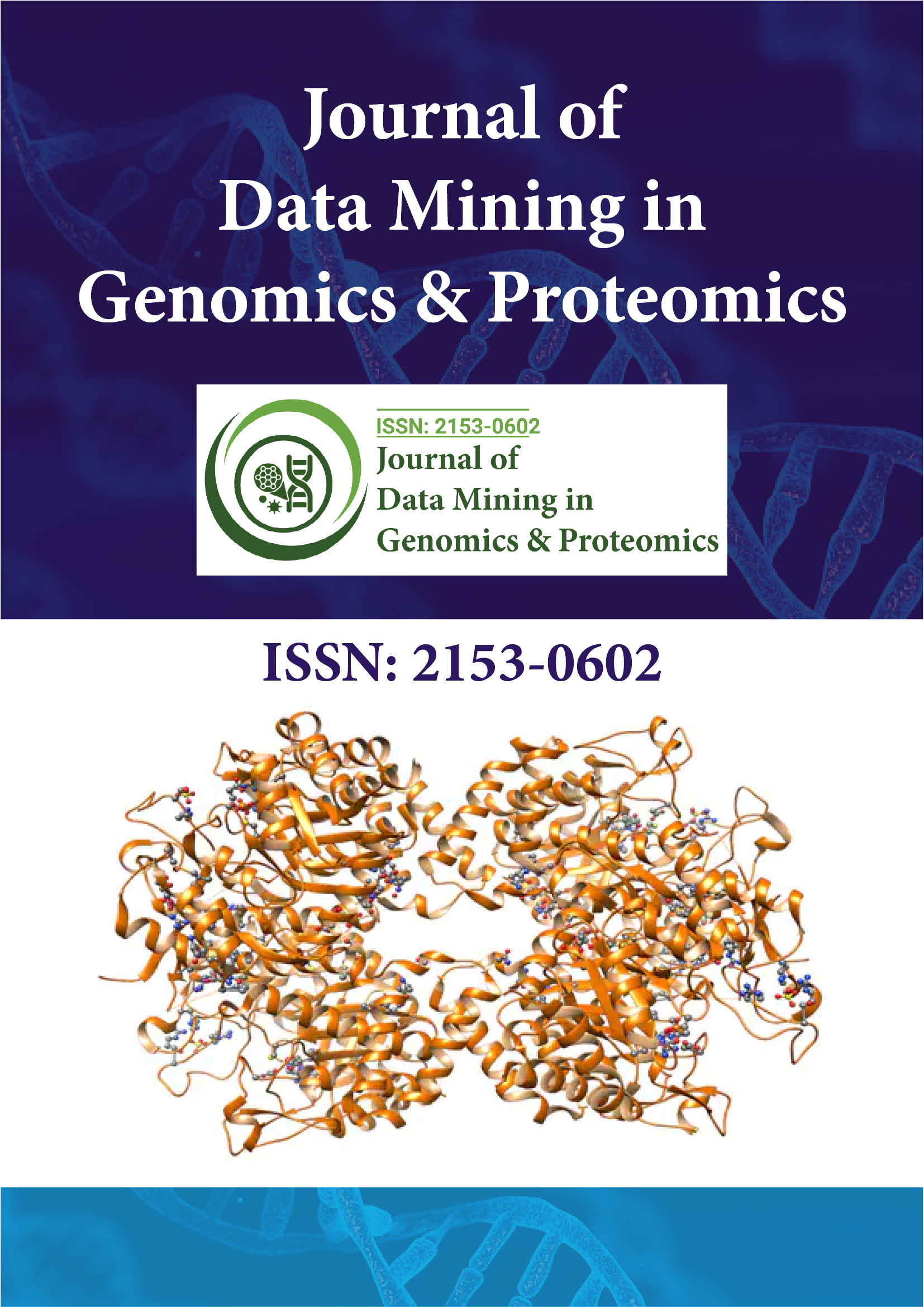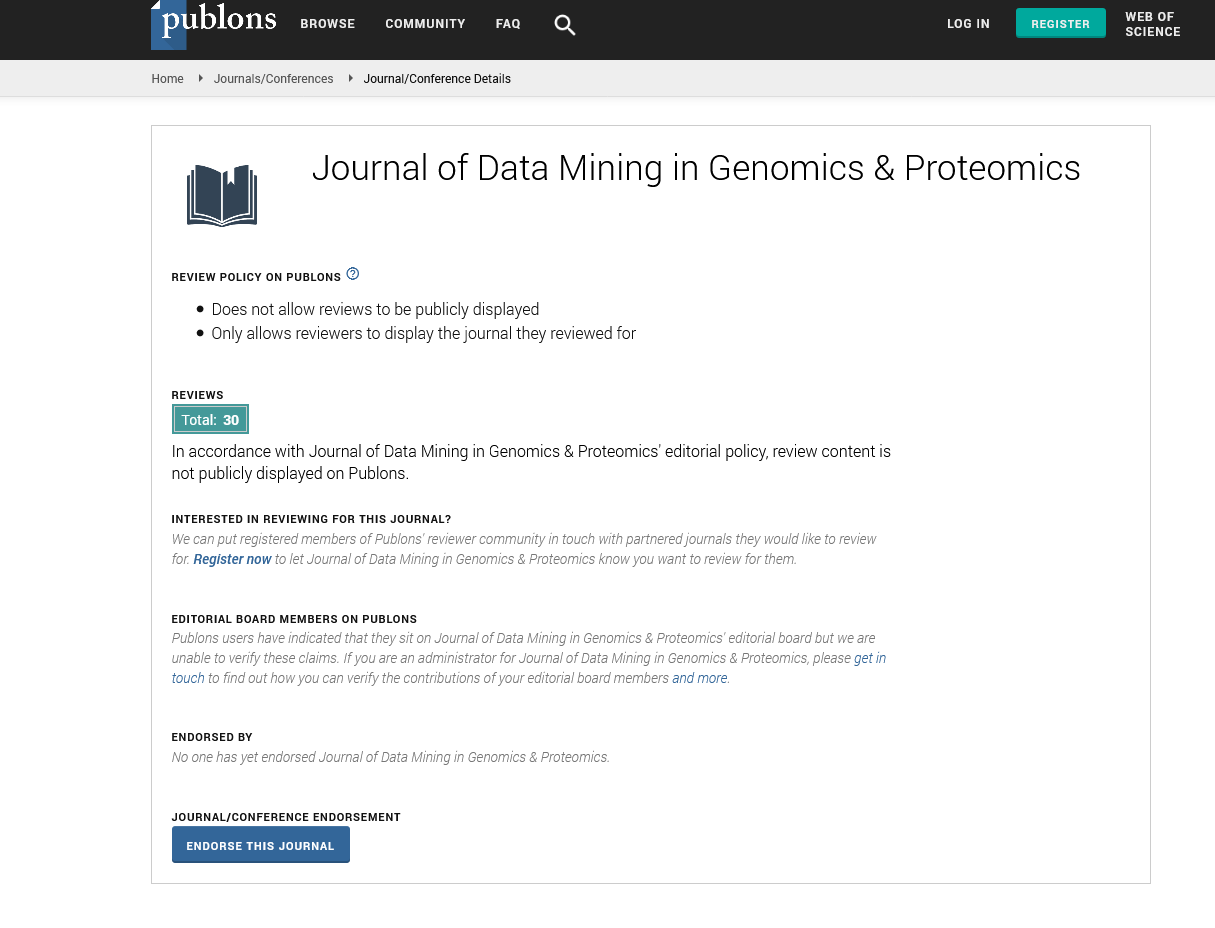Indexed In
- Academic Journals Database
- Open J Gate
- Genamics JournalSeek
- JournalTOCs
- ResearchBible
- Ulrich's Periodicals Directory
- Electronic Journals Library
- RefSeek
- Hamdard University
- EBSCO A-Z
- OCLC- WorldCat
- Scholarsteer
- SWB online catalog
- Virtual Library of Biology (vifabio)
- Publons
- MIAR
- Geneva Foundation for Medical Education and Research
- Euro Pub
- Google Scholar
Useful Links
Share This Page
Journal Flyer

Open Access Journals
- Agri and Aquaculture
- Biochemistry
- Bioinformatics & Systems Biology
- Business & Management
- Chemistry
- Clinical Sciences
- Engineering
- Food & Nutrition
- General Science
- Genetics & Molecular Biology
- Immunology & Microbiology
- Medical Sciences
- Neuroscience & Psychology
- Nursing & Health Care
- Pharmaceutical Sciences
Commentary - (2025) Volume 16, Issue 2
Exploring Epigenomic Patterns in Cardiovascular Disease through Data Mining
Emily Turner*Received: 29-May-2025, Manuscript No. JDMGP-25-29762; Editor assigned: 31-May-2025, Pre QC No. JDMGP-25-29762; Reviewed: 14-Jun-2025, QC No. JDMGP-25-29762; Revised: 20-Jun-2025, Manuscript No. JDMGP-25-29762; Published: 28-Jun-2025, DOI: 10.35248/2153-0602.25.16.381
Description
Cardiovascular disease continues to be one of the most pressing global health concerns, accounting for millions of deaths each year. While the genetic underpinnings of these conditions have been widely studied, there is increasing acknowledgment that epigenetic modifications significantly contribute to the onset and progression of cardiovascular disorders. Epigenetics refers to heritable changes in gene function that occur without altering the DNA sequence itself, often influenced by environmental exposures, dietary habits, stress and aging. These chemical modifications primarily DNA methylation, histone modifications and non-coding RNAs control the activity of genes in specific contexts. Advances in high-throughput sequencing technologies have now made it possible to map epigenomic landscapes on a large scale, but the complexity and size of these datasets demand powerful data mining methods to identify clinically relevant patterns.
One of the central areas of focus in cardiovascular epigenomic is DNA methylation, a process where methyl groups attach to cytosine residues within CpG sites, typically repressing gene transcription. Genome-wide methylation studies generate enormous amounts of information that cannot be analyzed manually. Computational algorithms and data mining approaches are applied to detect methylation signatures associated with hypertension, atherosclerosis, myocardial infarction and heart failure. For instance, hypo methylation of genes involved in vascular smooth muscle proliferation has been correlated with plaque formation, while hyper methylation of inflammatory mediators has been observed in advanced cardiovascular pathology. Such findings not only deepen the biological understanding of disease pathways but also highlight candidate biomarkers for early risk detection.
Histone modifications, including acetylation, methylation, phosphorylation and ubiquitination, add another regulatory layer by altering chromatin structure and accessibility. Through chromatin immunoprecipitation sequencing, researchers are able to map histone marks across the genome, identifying regions of active or repressed transcription. Data mining of these profiles has uncovered distinct histone modification signatures in failing cardiac tissue compared to healthy controls. By integrating histone modification maps with gene expression datasets, computational models can pinpoint regulatory circuits that are disrupted during disease progression, providing insight into mechanisms of maladaptive cardiac remodeling.
The discovery of non-coding RNAs has further expanded the landscape of cardiovascular epigenomic. MicroRNAs and long non-coding RNAs act as critical regulators of gene expression at post-transcriptional levels, influencing processes such as endothelial function, angiogenesis and cardiac hypertrophy. Mining RNA sequencing datasets has enabled researchers to identify networks of dysregulated non-coding RNAs in patients with coronary artery disease and heart failure. For example, altered microRNA expression profiles have been linked to increased fibrosis in the myocardium, while specific long non-coding RNAs appear to regulate lipid metabolism in vascular tissues. These findings suggest potential diagnostic and therapeutic applications, particularly as non-coding RNAs can often be detected in circulating blood.
The integration of epigenomic datasets with clinical parameters has opened new avenues for precision medicine in cardiovascular care. Machine learning algorithms are increasingly employed to analyze multidimensional data encompassing genetic, epigenomic and clinical features. Predictive models developed through these approaches can stratify individuals into high- and low-risk categories with greater accuracy than traditional risk factors alone. Such tools hold promise for guiding personalized interventions, where lifestyle modifications or pharmacological treatments may be targeted to individuals identified as genetically and epigenetically predisposed to cardiovascular disease. Despite these advances, several challenges continue to hinder progress. Epigenetic marks are often context-dependent and highly tissue-specific, making it difficult to extrapolate findings from easily accessible tissues such as blood to disease-relevant tissues like the heart or vasculature.
In addition, technical variability across platforms introduces background noise that complicates cross-study comparisons. Computational solutions such as ensemble learning, dimensionality reduction and normalization techniques are being applied to address these issues, but reproducibility remains a central concern. Furthermore, ethical and logistical challenges in large-scale epigenomic data sharing slow the pace of discovery, although international consortia are working to establish standardized pipelines. As technologies advance and analytical tools evolve, epigenomic profiling is poised to become an essential component of cardiovascular research and clinical practice. Mining large-scale epigenomic datasets not only enhances understanding of the molecular mechanisms underlying cardiovascular diseases but also paves the way for the identification of novel biomarkers and therapeutic targets. By linking environmental exposures with molecular regulation and clinical outcomes, epigenomic approaches bridge the gap between genetics and lifestyle influences. Ultimately, the careful integration of epigenomic insights into patient care could contribute to improved disease prevention, earlier diagnosis and more effective treatment strategies in the fight against cardiovascular disease.
Citation: Turner E (2025). Exploring Epigenomic Patterns in Cardiovascular Disease through Data Mining. Journal of Data Mining in Genomics & Proteomics. 16:381.
Copyright: © 2025 Turner E. This is an open-access article distributed under the terms of the Creative Commons Attribution License, which permits unrestricted use, distribution and reproduction in any medium, provided the original author and source are credited.

